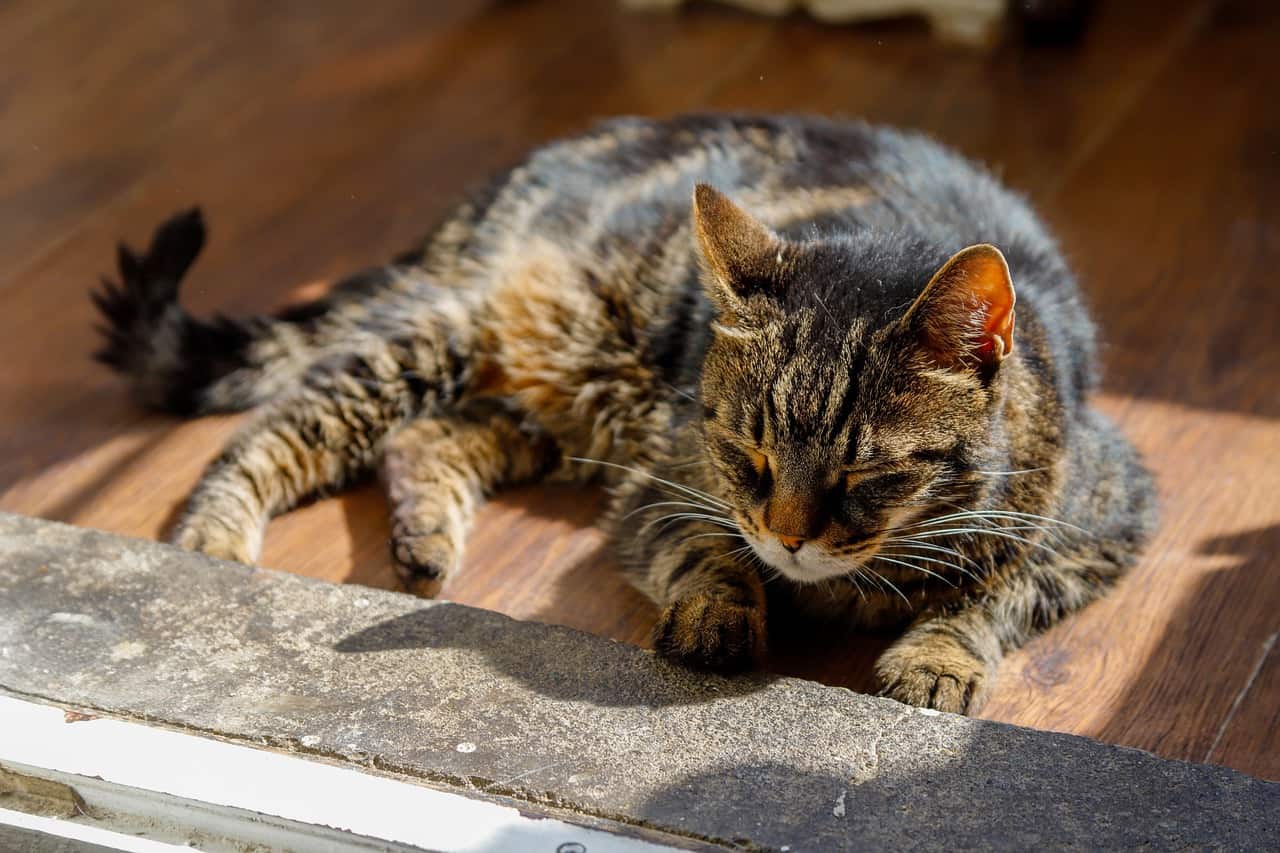Have you noticed your cat panting open-mouthed? In truth, we always hear about dogs and how Summer temperatures and being left in cars causes life-threatening heatstroke. But did you know that cats suffer from the effects of the sun and temperatures – even in their home? Cats cannot sweat through the skin, so similar to a dog, if their body overheats, heatstroke is imminent and becomes a potential killer.
A cat’s body temperature should be around 38.9 degrees Celsius. Heatstroke occurs when a cat’s body is unable to cope with warm or hot temperatures. It does not matter if your cat is indoors or outdoors. Cats are well-known for lazing in the sun but will eventually seek shade. During higher temperatures, it is rare you will see a cat outside in the day – after all, they wear a fur coat and coping with the heat too becomes difficult and dangerous. When a cat’s body temperature increases by 2-degrees, heatstroke can start. A dog is the same. The early will be drooling, open-mouthed panting and restlessness. At this point, it is a vital act and realise your cat is suffering and needs help becomes the heatstroke moves into a serious or fatal stage.
This article gives information on emergency first aid. This should be performed if your cat is displaying minor or major warning signs of heatstroke. Importantly, contact your vet. Your actions may save your cat’s life.
Can cats get heatstroke at home?
The answer is yes. Outside too. The best way to protect your pet from heatstroke is to keep them cool and hydrated in warm or hot weather.
Cats love the sun. My cat Tabitha does. She lazes on the armchair with the sun blazing through the picture window and door. Then suddenly, she moves out of the sun and finds a shaded spot on the carpet. I often wonder why she does not move into the lounge as the floor is tiled and it’s cool as the sun never filters into the room. She once panted with an open mouth, and when researching, I realised she was distressed and perhaps because she was unable to cool down.
A cat’s normal temperature is 38.9 degrees Celsius. I did not have a thermometer, so I never knew her temperature. I must admit, seeing her pant open-mouthed was alarming.
Points to be aware of:
Dogs are famed for suffering from the illness on walks, in cars, tied up outside without shade and water, or burning paws on hard ground. There is a 50% mortality rate for dogs with heatstroke. It is not often you see a cat outside during the day – most may choose to stay indoors or may find shade if left outside all day. Some cats have the option of staying indoors. A dog gets put into a hot car. A dog gets a lead attached and walked outside during peak times.
A barrier a cat faces is a thick fur coat. Imagine a hot Summer’s day, and you are wearing your thickest Winter coat indoors or outdoors? You would feel horrendous and unable to cope with the extra body heat. Imagine how a cat feels.
An example of situations in the home and garden that may contribute to heatstroke:
- An unventilalted room or house
- Full sun pouring in and it becoming as hot as an ‘oven’
- Lack of or no fresh water available
- Shut in the garden greenhouse
- Shut in the garden shed
- Outdoors catio or run without shade
- A room or building that transforms into an ‘oven-like’ structure
How can I help keep my cat cool indoors?
There are options available to keep your cat safe at home and preventative methods outdoors.
Suggestions to help keep your cat cool at home and in the garden without incident:
- Are you able to keep a window open or ajar with a security lock
- Close the curtains or blinds or at least partially so the sun is blocked out
- Buy large dog bowls and fill with chilled water, then put around the house in shaded areas
- Buy a cooling bowl – put it in the freezer till cold then fill with water for your cat
- Add icecubes to your cat’s watering bowl. Do not use shop bought icecubes as they might contain chemicals toxic to your feline
- Keep more than one filled water bowl outside in shaded areas
- Check your shed and greenhouse (or any place that may have an oven-effect )
- Ensure a catio or run has ample shade and water is available at all times
- Wet food contains moisture – consider buying wet food for your cat
I want to add a point if thinking of travelling with your cat. Do not travel in a vehicle with your cat at peak times (between 8 am to 8 pm) during hot summer months. Dogs can suffer early stages of heatstroke during temperatures as little as 20 degrees, and chances are your cat is the same. When I travel for 2 to 3 hours to visit family and Tabitha comes with me, we begin our journey no later than 6 am. By 8 am, the temperature begins climbing, and I start worrying.
We can help our cats keep cool indoors. A selection is my own tips are:
- Soak a sponge with cool water and squeeze on to kitty then gently rub the sponge over kitty so absorbes into the fur
- Wet an old tea towel and drape over your cat
- Fill a hot water bottle with cool water and place by your resting cat
- Keep your cat groomed so dead fur is removed. It will thin out the coat
- Periodically use a fan – although I bought one and my geriatric cat Molly refused to lay in front of it
- Invest in a cooling mat – I cannot guarantee your cat will use it but you never know
- Turn on your hose outside to a mist setting – my cat loved it!
As previously mentioned, a cat’s panting will increase when your cat is very hot and distressed. A feline requires lots of cool fresh water and ventilation to keep its body temperature normal. Remember, a cat will find it hard to keep themselves cool. They rely on our help.
How can you tell if a cat is developing heatstroke?
We shall look at the initial stages of heatstroke then the more serious stages.
Early stages:
- Panting open-mouthed
- Drooling from the nose and mouth
- Over-grooming
- Restless and moving place to place
- Distress
When a cat is panting, they are attempting to rid themselves of extra heat.
Serious signs as heatstroke progress- act now:
- Stumbling and lack of balance
- Vomiting and / or diarhaoe (may include blood)
- Increased heatrate (normal rate is 160 to 180 beats per minute)
- Tiredness
- Less active than normal
- Dehydration
- Very little or no urine
- Red tongue
- Foaming at the mouth (this can also relate to a toxic ingestion)
It is worth noting that flat-nosed felines and breeds such as Persian, British Shorthair are more susceptible to heatstroke because of the structure of their respiratory system. Elderly and overweight cats should be monitored for symptoms too.
Points to beware of:
- When a cat’s temperature reaches 39 to 40 degrees and shows early signs of heatstroke, it is time to approach a vet. A high temperature can contribute to organ damage
- When a cat’s temperature tncreases to 40.55 degrees and over, then heatstroke becomes life-threatening and can be fatal
Emergency first aid for cats having heatstroke
Heatstroke is serious. By being observant, or if you suspect your cat has early or more extreme warning signs of heatstroke, please act and call your vet based on an emergency. This move is important. I understand it may be difficult to recognise whether the symptoms are serious, or you may doubt yourself. But it is better to take precautions than risk organ damage or a fatality.
Is your cat distressed because it has become too hot:
- Move your cat to a cooler shaded place
- Lay your cat on a cool surface
- Give your cat cool and encourage your cat to drink
- Gently wet your cat’s ears and paw pads to help a cool down
- Call your vet and explain the situation
Is your cat distressed, but conscious and you have identified issues:
- Move your cat to a cooler shaded place
- Encourage your cat to drink cooled water
- Gently wet your cat’s ears and paw pads to help a cool down
- Soak a towel with cool water and lay across your cat – cooling your cat may save your cat’s life
- Call your vet as an emergency
Is your cat unconscious:
- Move your cat to a cooler shader place
- Soak a towel with cool water and lay on your cat to help cool it
- Call your vet as an emergency
- Ask your vet if they advise putting a bag of frozen food in between your cat’s legs
Never dowse your cat in ice-cold water – the reaction between a hot body temperature and cold water can send your cat into shock.
Related questions
How long does it take a cat to recover from heatstroke?
Really, it will depend on how far developed the heatstroke is. Your veterinary surgeon is the best person to judge the seriousness of the condition. If your cat survives, then recovery maybe days. Or, if the heatstroke is more developed, then there may be long term organ damage. Don’t forget to follow emergency first aid, then urgently transport your cat to a vet for treatment.
How will a vet treat my cat for heatstroke?
Medical treatment by a veterinary surgeon will depend on the level of heatstroke. Your vet is qualified to decide on the treatment required.
An example of treatment:
- Oxygen
- Intravenous fluid
- Blood tests to determine if there is organ damage
- Your cat may be hospitalised until it is safe for discharge
- Eventually at home monitoring and possibly a follow up appointment
But not every cat will be lucky enough to survive.
How can I take my cat’s temperature?
A vet will take a cat’s temperature rectally, which gives a more accurate reading. I don’t know about you, I couldn’t in case I hurt my cat. I recommend an in-ear thermometer.
- Place the thermometer inside your cat’s ear
- Hold the thermometer horizontally
- It is important to keep your cat’s head still so h a friend for help
- The device will bleep and give the current temperature
Thermometers and cooling mats are available at** Viovet
Disclaimer:
This post contains affiliate links and highlighted with **. I only recommend products I would use myself, and all opinions expressed here are my own. I earn commissions if you purchase products from retailers after clicking on a link from our site at no additional cost to you. As an Amazon Associate LLP, we earn from qualifying purchases.
I am not veterinary trained. Signs, as detailed in this article, can be similar to other health issues. Heatstroke, however, is a serious illness, so please seek urgent help from a veterinary professional. Immediate actions may save your cat’s life.
Poppys Pets is a participant in Awin and Amazon Associate affiliate programs which compensates me for referring traffic. It is of no extra cost to you and if thinking of buying a product, please consider using my link. It\'ll earn Poppy\'s Pets a few pennies to continue to this website. Only a selection of articles and videos on this website and YouTube channel contains affiliate links. Further information: Disclaimer and Privacy Policy

